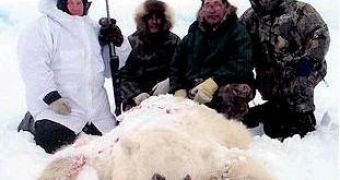Global warming is a reality, and the Arctic is affected by it the hardest. Our grandchildren may not get to see polar bears, at least not in the wild. In the summer of 2007, the Arctic ice surface was about 30% under the long-term average level, a record of all times. Some studies forecast ice-free Arctic summers by 2040; some say that we could even get to see it happening this year.
Since 1978, the trend has been only downward and the Arctic is annually losing 44,000 square kilometers (18,000 square miles) on average. However, this is not only about surface. The current Arctic ice is thin and young, just one year old, being much more unstable than thick ice that accumulates over several years. New ice melts more quickly, and then open water absorbs more sunlight, warming the seas and determining the fall frost to come even later.
Polar bears prefer ice over the shallow continental shelves north, because they support a richer food chain. With the melting of last summer, Alaska bears were on ice as much as 600 miles (960 km) north of Barrow, far from their preferred habitat. By 2050, the Alaskan polar bears will have disappeared due to global warming.
Until then, one of the effects of Arctic ice melting is an increased number of "grolar" bears, hybrids between a polar bear and grizzly bear, that appear because of the increasingly overlapping areas, as signaled by The Sun newspaper.
"One of the real things that is happening is that grizzlies are moving north, at the same time the polar bears are forced to be on the beach, and we have found a number of grizzly bear-polar bear hybrids. Essentially, that could mean that it would save the polar bear genes in the grizzly population," biologist Dr George Divoky, an Institute of Arctic Biology Research Associate who has worked in the Arctic region for over three decades, told The Sun.
A white bear with brown patches shot in northern Canada in April 2006 was confirmed, thanks to DNA analysis, to be a 'grolar' bear, the product of a male grizzly and a female polar bear. The two species can interbreed easily, as in fact the polar bear is an offshoot of the grizzly bear (called brown bear in Eurasia).
The brown bear (Ursus arctos) appeared 600,000 years ago in Asia. It colonized the whole Eurasia and, 100,000 years ago, crossed the Behring into North America, giving birth to the grizzly forms. Some of these individuals remained prisoners on ice packs. They adapted to this environment and, through adaptations and color change, the polar bear (Ursus maritimus) appeared. Thus, the polar bear could be considered the youngest of all bear species. "Having seen things, I would never be surprised if in 2008 the summer ice disappears. This has never happened in the period of human observation," Divoky added.
Divoky has been investigating the ecology and biology of the guillemot (a sea bird) on Cooper Island, off the northern coast of Alaska, spending the summer on the island each year. He has witnessed one of the first effects of the warming on Cooper Island: the island is currently being invaded by hungry polar bears, left behind by the retreating ice. From 1975 to 2002, Divoky saw only 3 polar bears. Now, they are an annual occurrence and, just recently, he saw 20 in 3 days.
"Having a polar bear show up in your front yard is one of the more compelling pieces of evidence that climate change is real. All of those animals who depended on the ice being there, won't have the ice there. It will impact the populations because there will be fewer young. It's critical in terms of providing food in the way of either fish or seals, it means that the organisms depending on that will have less food available and they will suffer in terms of their body condition and ultimately starving," Divoky concluded by saying.

 14 DAY TRIAL //
14 DAY TRIAL //